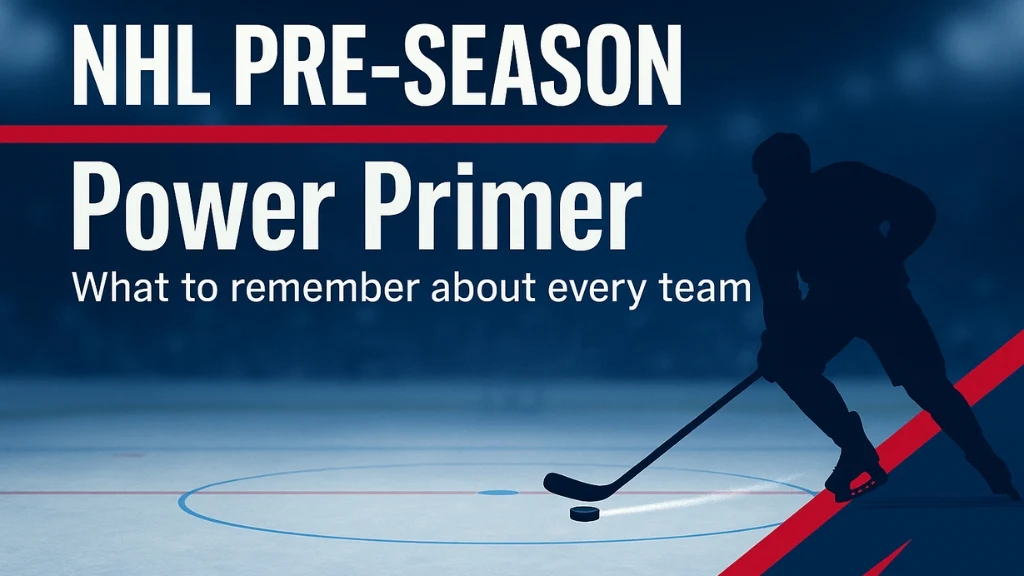The NHL pre-season context that actually matters
The puck is about to drop on the 2025–26 NHL Pre-Season Power Primer, a reset moment when summer headlines finally meet real line rushes, special-teams reps and first-look chemistry. Florida’s back-to-back Cup run is in the rear-view, camps are open, and we’re inside three weeks of meaningful games.
Pre-season is never a perfect predictor, but it is where contract standoffs crystalize into absences, health flags become usage tweaks, and coaches trial the combinations they’ll lean on in October. Think of it as a league-wide shakedown cruise: who’s signed, who’s skating, who’s switching positions, and who’s stepping into a bigger role are the items to truly remember now.
Contract clouds and leverage plays that shape early storylines
A surprising number of contenders and risers begin camp with deal dynamics that could sway their October. In Anaheim, top-six center Mason McTavish has no contract and isn’t in camp, an absence that matters for a young Ducks core looking to take a step; history says prolonged stalemates can dent in-season performance, and Anaheim can’t afford that at the pivot. In Boston, the organization is already whispering “load management” for David Pastrnak after early-camp tendonitis; the Bruins, light on returning 20-goal scorers, need his volume shooting and gravity, so this subtle health story deserves close watch.
Colorado’s position is different but no less pivotal: Martin Nečas, brilliant next to Nathan MacKinnon after the Rantanen trade, is entering a walk year; if he pushes toward a $10M-ish number, the Avs may face another value-vs-window decision. Dallas, meanwhile, has Jason Robertson headed toward RFA status with arbitration eligibility—a path that could walk him right to UFA the year after and quietly pressure the Stars’ cap planning. Each case nudges the roster chessboard before a real puck is dropped.
Trade drums, camp no-shows, and don’t-ignore smoke signals
Some situations already feel like slow-burn trades in the making. Calgary captain Mikael Backlund has said out loud what everyone believes about Rasmus Andersson: a move is coming before his deal expires, with the twist that a departure would open both a hole and an opportunity, potentially fast-tracking right-shot rookie Zayne Parekh.
In Columbus, Yegor Chinakhov requested a trade after a season that began on the top line but slid downhill with injury and scratches; he’s in camp and could play his way into minutes—and maybe off the market—but the request colors everything. These aren’t one-day camp notes; they’re arcs likely to carry through the pre-season into the deadline.
Superstars, center shifts and Olympic-year motivations
A handful of headline talents enter pre-season with extra narrative fuel. Chicago’s Connor Bedard, now in his contract year, is chasing not just a platform season but also an Olympic roster spot in a field suddenly complicated by Macklin Celebrini’s rocket ascension; Bedard’s per-game dip from year one to two makes this a statement camp.
In New York, Artemi Panarin’s next deal arrives as winger prices inflate league-wide; he was still the Rangers’ steadying scorer through turbulence, but age-curve math and cap geometry make this negotiation one of the most intriguing in the league. The Islanders plan to push Mat Barzal back to center under Patrick Roy, a move that demands two-way stamina—and comes as Barzal returns from right knee surgery. These are not cosmetic tweaks; they alter usage, linemates and the way opponents game-plan.
Goaltending realities that can swing seasons
Few realities shape ceilings like goaltending, and a couple of East powers embody that truth. New Jersey stabilized its crease by adding Jacob Markström last year, improving dramatically in goals-against; now he’s in a contract year and turns 36 mid-season. Lose him next summer without succession certainty and the Devils’ carefully rebuilt foundation wobbles.
In Florida, Sergei Bobrovsky’s status is the most interesting single-player cap story on the defending champs; he’s 37, worth every penny on performance, and still the heartbeat of their identity. The questions are term, dollars and succession plan, and while none will be fully answered in September, usage patterns and depth auditions in the pre-season will hint at what the front office believes.
Prospects and sophomores who can tilt depth charts
Pre-season is prospect season, and several clubs could see young talent make October math easier. Montreal might flirt with an exceedingly rare feat: back-to-back Calder Trophies. After Lane Hutson lapped the rookie field last year, Ivan Demidov arrives as a favorite after torching a prospects event and looking NHL-ready at a glance; if he sticks, Martin St. Louis gets instant top-six juice.
In Edmonton, the biggest off-ice story is Connor McDavid’s future, but the near-term competitive boost could come from rookies Matt Savoie and Ike Howard if either shows he can ride shotgun with McDavid or Leon Draisaitl. And in Los Angeles, the most important development is internal: Quinton Byfield finishing last season as a top-25 scorer from February onward. If that surge stretches across a full campaign—especially as Anze Kopitar embarks on his final year—the Kings’ center succession plan looks far more secure.
Cap handcuffs loosen and rebuild clocks tick louder
The Wild finally get to breathe. With the punitive Parise/Suter buyout penalties eased, Minnesota can shop meaningfully again, a freedom that matters both for deadline maneuvering and for demonstrating to Kirill Kaprizov that the organization can keep pushing up a tier. Out in Detroit, the “Yzerplan” enters year seven. Patience has been the brand, and the Wings have flirted with the bubble, but missing by five last year while rivals leapt past them tested the market’s tolerance.
Marco Kasper’s strong finish hints at an internal bump, and Simon Edvinsson’s larger role should materialize later despite missing camp, but the ninth straight playoff miss looms; stretching that to ten would be a mood swing moment. Pre-season won’t decide either story, but it will show pace, health and system fit—useful tells for where each arc is headed.
Health watch, usage clues and the art of reading September
September success can be fool’s gold, but September usage is a compass. Watch who gets top-unit power-play reps and how long coaches run those looks; those choices often persist into the first real road trip. In Boston, even a brief Pastrnak slowdown shifts early PP designs and five-on-five matchups. On Long Island, Barzal’s shift to center will be telegraphed by faceoff workloads and who flanks him; if the staff trusts him with heavy defensive-zone starts, the experiment is all-in.
In Colorado, Nečas’s minutes with MacKinnon will indicate whether the club is prepared to pay the number elite production demands—or keep contingency options warm. And in Dallas, Robertson’s camp form and preseason rhythm matter to a front office weighing arbitration leverage against a Cup window. Pre-season is where those choices are rehearsed in public.
The “unlucky” bounce-back candidates and regression watch
If you’re hunting for a club that could outperform its vibes, keep an eye on Nashville. The Predators posted the league’s worst PDO last year, a cocktail of a bottom-tier shooting percentage and subpar save rate that rarely repeats. A bounce from Juuse Saros toward his career norms plus second-year comfort for Steven Stamkos and Jonathan Marchessault could drag the offense and goals-against toward league average again.
That’s the optimistic read in a room determined to embarrass the projections for a third straight season under Barry Trotz’s watch. The pessimist’s counter is that the core is aging while young talent hasn’t fully popped. The truth usually lives in the middle—but September will at least tell us whether the puck is following them again.
How to watch the rest of camp like a pro
Filter the noise. Focus on absences tied to contracts, veterans managed for health, position switches for star forwards, goaltending pecking orders, and whether teams with ambitions look decisive in their top nine and top four. Teams with clean hierarchies now usually start fast in October; teams still blendering lines into the final exhibition tend to open 4–6 while they search.
If you’re tracking rookies, ignore raw points and watch usage: penalty-kill trust, defensive-zone draws, top-six time against legit NHLers. And if you’re thinking like a GM, keep two bins in mind—walk-year leverage cases and deadline cash/space plans. Between Jacob Markström’s contract horizon, Sergei Bobrovsky’s future, Martin Nečas’s number, Jason Robertson’s RFA pathway, and the Wild’s newfound flexibility, September decisions are already shaping March possibilities.







